Where Did They Put the Gestapo Headquarters?-A Walking Tour of Nazi Occupied Paris
Volume One Available Now!
BRING OCCUPIED PARIS TO LIFE
(without obtaining a ration card to survive)
Come walk in the footsteps of the men, women, and children who lived, worked, and died in Nazi-occupied Paris. Your walks will take you to buildings, places, and sites that were significant to the Nazis, French Resistance, Free French, the British, and most important, the citizens of Paris.
“Stew blends the dark history of buildings in Paris that are associated with the infamous deeds of the Gestapo with contrasting insights into the bravery of the French people, who, at great risk to themselves and their families, secretly resisted the German Occupation.”
⏤Squadron Leader Stanley Booker, MBE, RAF (Ret.), Chevalier de la Légion d’honneur, Member: KLB Club
Our new book, Where Did They Put the Gestapo Headquarters? A Walking Tour of Nazi-Occupied Paris, is also available for sale direct from Stew and Yooper Publications.
The price of the book is $24.95. All books sold directly will be autographed with a personal message.
For our domestic subscribers, we’ll pay the postage. For our international subscribers (and non-subscribers), the cost of postage will be added to the cost of the book. If you would like to own and read our new book, please contact Sandy directly at sandy.ross@yooperpublications.com.
Your review of the book on Amazon would be greatly appreciated (click here).
Although World War II and the German occupation of Paris occurred more than 75 years ago, these historical events are still fresh in our minds. France spent almost 40 years denying its role in the collaboration with the Nazis and in particular, the arrests and deportations of the French Jewish population. While the German occupation of Paris started out rather benignly in June 1940, within two years the city and its citizens were firmly in the grip of the tightening Nazi vise.
Coming Soon!
Volume Two coming in2024! Volume Three in 2025!
WHAT ARE THE BOOKS ABOUT?
You will visit the buildings, places, and sites that were significant to the German occupation between June 1940 and August 1944. By the end of the first day of occupation (14 June) it was clear the Germans knew their way around Paris. Almost overnight every German military, administrative, and political entity had moved into their new quarters. Subsequent to Hitler’s election in 1933, the pre-war German Abwehr (intelligence) in Paris had clearly mapped out potential sites to be requisitioned for an eventual occupation.
Volume One
CONTENTS
WALK ONE (Vichy France)
Louis Darquier de Pellepoix to the Kommandantur du Groß -Paris
WALK TWO (PARIS BY NIGHT)
Cabaret le Shéhérazade to the Milice Headquarters
WALK THREE (SOLDIERS ON LEAVE)
Montmartre: UGIF to the Moulin Rouge
MÉTRO WALKS (OTHER SITES TO VISIT)
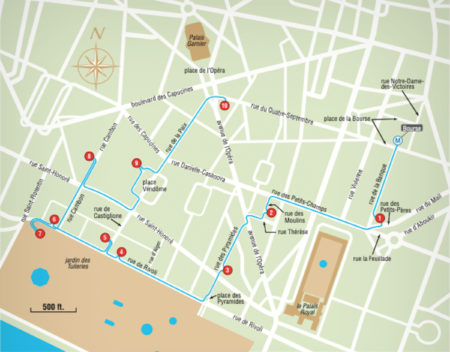
Your first walk in the historic district includes a former brothel, the approved bookstore for German soldiers, the Hôtel le Meurice (where they left a bullet hole in the sign above the entrance), and the site of the former Kommandantur du Groß-Paris, or Commander of Greater Paris near Le Palais Garnier. You will stop at the Hôtel Ritz where Coco Chanel lived with her lover, senior Abwehr intelligence officer, Baron Hans Günther von Dincklage (“Spatz”). Was Chanel a Nazi collaborator or spy?
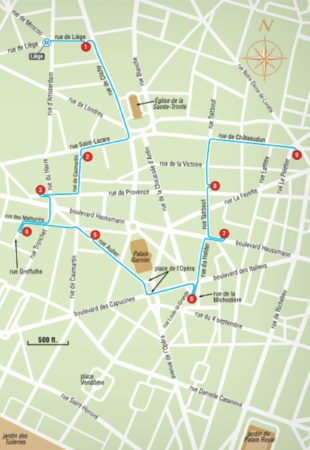
The second walk, “Paris by Night,” takes you to the site of the former premier Paris nightclub, Cabaret le Shéhérazade, the building where the infamous brothel, Le One-Two-Two, was located, and the former headquarters of the dreaded Milice, Vichy’s paramilitary group.
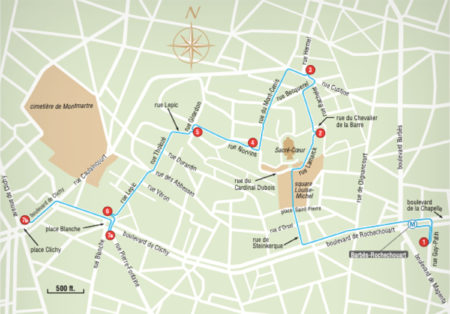
Walk Three, “Soldiers on Leave,” ends up in the Montmartre district with visits to several Wehrmacht Soldatenheims (i.e., soldier’s clubs), the legendary Moulin Rouge, and the historic restaurant, Á la Mère Catherine. Our Métro Walks include a trip to Saint-Germain-en-Laye, headquarters for Oberbefehlshaber West, where you will visit the bunkers built for the Wehrmacht commander-in-chief in the west. Another trip outside Paris takes you to Champigny-sur-Marne where the Musée de la Résistance nationale, or National Museum of Resistance is located. Situated in the fourth district, just a short walk from the Seine, is the Mémorial de la Shoah, a memorial to the Holocaust victims.
“Maybe I’ll protect it; maybe I won’t. It’s up to me.”
Adolf Hitler
(to Albert Speer on the fate of Paris sometime during their three-hour tour of Paris on the morning of 28 June 1940)
WHY WOULD YOU BUY MY BOOK?
There are three basic reasons why you might consider this book.
First, you may have been to Paris several times and you’re looking for something new to do. You have an interest in World War II and in particular, the occupation years of Paris.
Second, there really aren’t any books quite like this one. It is well researched and pinpoints the significant buildings that played an important role during the Occupation and immediately after the Liberation.
Third and probably the most important reason, I will introduce you to people you’ve probably never heard of. These include the Résistants (French resistance members), Collabos (collaborationists), Germans, and the victims, just to name a few. You will learn about their stories: some heroic and some sad.
German soldiers touring Montmartre. Notice Sacré-Cœur de Montmartre in the background? Photo by anonymous (date unknown). Secrétariat d’Etat Chargé des Anciens Combattants et des Victimes de Guerre Mission Permanente aux Commémorations et à l’Information Historique.
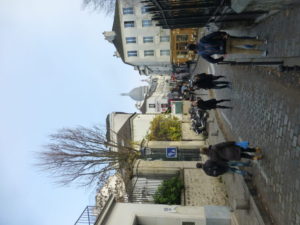
View of Rue Norvins looking SE towards Sacré-Cœur. Same view as image on the left. Notice the arched brick entrance in the photo on the left has been replaced with a modern entrance on the extreme left of this contemporary image. Photo by Raphaelle Crevet (2016). PD-Photographer release.
Copyright © 2015 -2024 Yooper Publications LLC







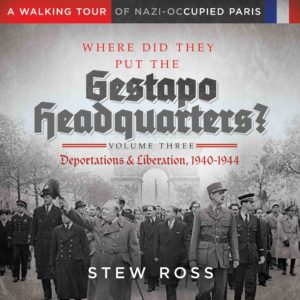
 Stew Ross is a retired commercial banker turned author and publisher. When he and his wife Sandy aren't traveling and researching his next book, they enjoy spending time in their pool in Southwest Florida.
Stew Ross is a retired commercial banker turned author and publisher. When he and his wife Sandy aren't traveling and researching his next book, they enjoy spending time in their pool in Southwest Florida.